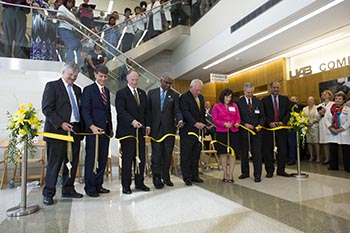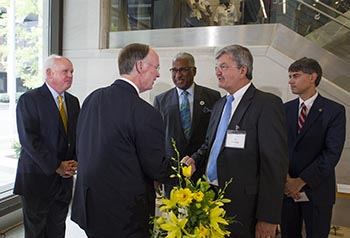On Friday, Aug. 23, the University of Alabama at Birmingham (UAB) Comprehensive Cancer Center celebrated the public grand opening of the renovated Lurleen B. Wallace Tumor Institute (WTI). Gov. Robert Bentley, state Rep. Paul DeMarco, and Birmingham Mayor William Bell joined UAB leaders in a ribbon-cutting ceremony at the WTI, 1824 6th Ave. South.
Gov. Bentley, a dermatologist, recounted how difficult it is for a physician to tell a patient of a diagnosis of cancer. He stressed that the UAB Comprehensive Cancer Center provides patients with a measure of hope and pledged his support.
“We are going to continue to work with you at the state level, and I will work with you as a physician,” said Bentley. “I want to do what is best for the people of our state and of our community. God bless you for what you do.”
Mayor Bell and Rep. DeMarco praised the physicians, scientists and staff of the UAB Cancer Center.
“Today is your day to be recognized for the outstanding work you’ve done since 1974,” Bell said. “Today is your day to know that this great institution is willing to invest in you to continue the work you do to bring honor to the research and developments that come out of this institution.”
“As someone who has lived here his entire life, I am so humbled to be here,” said DeMarco. “Humbled because of the history of this place, and of the innovation and research that has taken place here.”
 The ceremony drew a standing room only crowd of more than 400 people that included faculty, employees, patients, benefactors and community members.
The ceremony drew a standing room only crowd of more than 400 people that included faculty, employees, patients, benefactors and community members.
“Our goal is to create an interactive, multi-disciplinary environment that ultimately brings premium cancer care to our patients quickly and safely, and we’ve done that with these renovations,” said Edward Partridge, M.D., director of the Comprehensive Cancer Center. “The UAB Cancer Center is distinguished by the breadth and depth of our research and our disease-specific approach to cancer care, and this brings our scientists together in one location to increase collaboration and foster scientific breakthroughs.”
Originally built in 1975, the Wallace Tumor Institute is the hub of the Cancer Center’s research and administrative enterprise. A massive, $30 million renovation to modernize and enhance the building, paid for with state bonds, began in 2010. New additions and improvements include larger and more open laboratory space designed to encourage communication and collaboration, a clearly marked and welcoming front door and an Advanced Imaging Facility (AIF) that includes a new cyclotron and state-of-the-art PET imaging equipment.
“We are exceptionally proud of this new building, which has undergone a truly remarkable transformation, and it would not have been possible without the investment of the people of this great state,” said UAB President Ray L. Watts. “These renovations will enable us to serve the people of Alabama even more effectively, pushing the envelope further to find revolutionary new treatments, train more health-care workers to deliver the best treatments and ensure the newest-generation therapies are available here in Birmingham, Ala., to all.”
 As the only National Cancer Institute-designated comprehensive cancer center in the Deep South region comprising Alabama, Mississippi, Louisiana, Arkansas, South Carolina and Georgia, the UAB Cancer Center is home to more than 350 physicians and researchers.
As the only National Cancer Institute-designated comprehensive cancer center in the Deep South region comprising Alabama, Mississippi, Louisiana, Arkansas, South Carolina and Georgia, the UAB Cancer Center is home to more than 350 physicians and researchers.
One of the highlights of the building is the UAB Advanced Imaging Facility located in the basement. The only place in the building where patients will be seen, it houses the most innovative, cutting-edge PET imaging equipment and expands UAB’s capability for clinical and experimental PET. The AIF has two time-of-flight GE Discovery 710 PET CT scanners and plans to add at least two more. These new scanners will allow better image quality, faster imaging protocols and optimized attenuation correction, while lowering patient radiation doses. The AIF eventually will feature a state-of-the-art PET/MR system, unique to the state of Alabama and the area.
“We have specially trained UAB PET faculty who will use this cutting-edge equipment to improve diagnosis and monitoring of treatment response in the fields of oncology, neurosciences and cardiology,” said Janis O’Malley, director of the Division of Molecular Imaging and Therapeutics and associate professor in the UAB Department of Radiology. “With this technologically advanced equipment, we now are in a position to take our clinical and research practices even further and solidify UAB’s position as a leader in PET technology.”
The core of the AIF is the 61,000-lb. cyclotron, the most powerful at any academic medical center in the United States. UAB’s TR24 cyclotron is a type of particle accelerator that moves protons — one kind of charged particle comprising atoms — along a spiral path to strike a target. It will enable researchers to make a variety of agents in quantities large enough to advance several clinical and research efforts.
In addition, the WTI facility has six above-ground floors. The first and second floors are for administrative use and are strategically connected to UAB Hospital. Designed with environmentally friendly and energy-efficient materials and decorated with modular furniture, the facility has training and conference spaces and a patient-education center. Faculty offices face each other so scientists can exchange ideas more easily. Open, well-lit laboratories, with 10-12 research teams located on each floor, line the perimeter of the building with internal specialty rooms.
“We are so excited that this world-class facility has come to fruition,” Partridge said. “This is an investment of which Alabamians can be proud. This really is the people’s Cancer Center. Although the building is beautiful, modern and functional, the work that goes on in this building is what matters most. It will help deliver the best care possible to the citizens of this community, state and region.